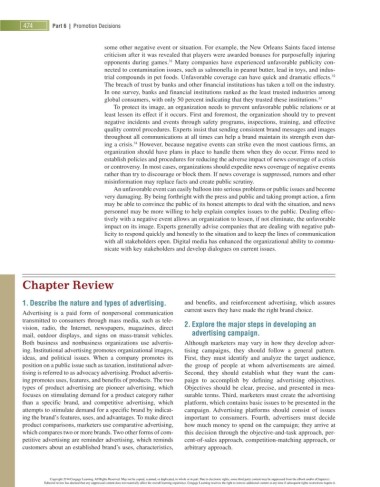Page 507 - Foundations of Marketing
P. 507
474 Part 6 | Promotion Decisions
some other negative event or situation. For example, the New Orleans Saints faced intense
criticism after it was revealed that players were awarded bonuses for purposefully injuring
31
opponents during games. Many companies have experienced unfavorable publicity con-
nected to contamination issues, such as salmonella in peanut butter, lead in toys, and indus-
32
trial compounds in pet foods. Unfavorable coverage can have quick and dramatic effects.
The breach of trust by banks and other financial institutions has taken a toll on the industry.
In one survey, banks and financial institutions ranked as the least trusted industries among
33
global consumers, with only 50 percent indicating that they trusted these institutions.
To protect its image, an organization needs to prevent unfavorable public relations or at
least lessen its effect if it occurs. First and foremost, the organization should try to prevent
negative incidents and events through safety programs, inspections, training, and effective
quality control procedures. Experts insist that sending consistent brand messages and images
throughout all communications at all times can help a brand maintain its strength even dur-
34
ing a crisis. However, because negative events can strike even the most cautious firms, an
organization should have plans in place to handle them when they do occur. Firms need to
establish policies and procedures for reducing the adverse impact of news coverage of a crisis
or controversy. In most cases, organizations should expedite news coverage of negative events
rather than try to discourage or block them. If news coverage is suppressed, rumors and other
misinformation may replace facts and create public scrutiny.
An unfavorable event can easily balloon into serious problems or public issues and become
very damaging. By being forthright with the press and public and taking prompt action, a firm
may be able to convince the public of its honest attempts to deal with the situation, and news
personnel may be more willing to help explain complex issues to the public. Dealing effec-
tively with a negative event allows an organization to lessen, if not eliminate, the unfavorable
impact on its image. Experts generally advise companies that are dealing with negative pub-
licity to respond quickly and honestly to the situation and to keep the lines of communication
with all stakeholders open. Digital media has enhanced the organizational ability to commu-
nicate with key stakeholders and develop dialogues on current issues.
Chapter Review
1. Describe the nature and types of advertising. and benefits, and reinforcement advertising, which assures
current users they have made the right brand choice.
Advertising is a paid form of nonpersonal communication
transmitted to consumers through mass media, such as tele- 2. Explore the major steps in developing an
vision, radio, the Internet, newspapers, magazines, direct
mail, outdoor displays, and signs on mass-transit vehicles. advertising campaign.
Both business and nonbusiness organizations use advertis- Although marketers may vary in how they develop adver-
ing. Institutional advertising promotes organizational images, tising campaigns, they should follow a general pattern.
ideas, and political issues. When a company promotes its First, they must identify and analyze the target audience,
position on a public issue such as taxation, institutional adver- the group of people at whom advertisements are aimed.
tising is referred to as advocacy advertising. Product advertis- Second, they should establish what they want the cam-
ing promotes uses, features, and benefits of products. The two paign to accomplish by defining advertising objectives.
types of product advertising are pioneer advertising, which Objectives should be clear, precise, and presented in mea-
focuses on stimulating demand for a product category rather surable terms. Third, marketers must create the advertising
than a specific brand, and competitive advertising, which platform, which contains basic issues to be presented in the
attempts to stimulate demand for a specific brand by indicat- campaign. Advertising platforms should consist of issues
ing the brand’s features, uses, and advantages. To make direct important to consumers. Fourth, advertisers must decide
product comparisons, marketers use comparative advertising, how much money to spend on the campaign; they arrive at
which compares two or more brands. Two other forms of com- this decision through the objective-and-task approach, per-
petitive advertising are reminder advertising, which reminds cent-of-sales approach, competition-matching approach, or
customers about an established brand’s uses, characteristics, arbitrary approach.
Copyright 2014 Cengage Learning. All Rights Reserved. May not be copied, scanned, or duplicated, in whole or in part. Due to electronic rights, some third party content may be suppressed from the eBook and/or eChapter(s).
Editorial review has deemed that any suppressed content does not materially affect the overall learning experience. Cengage Learning reserves the right to remove additional content at any time if subsequent rights restrictions require it.

